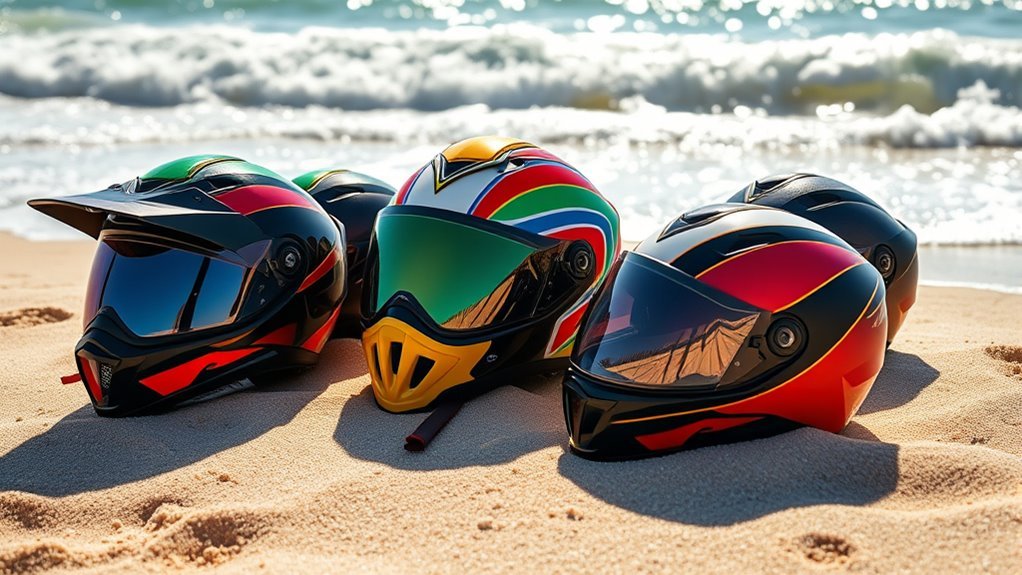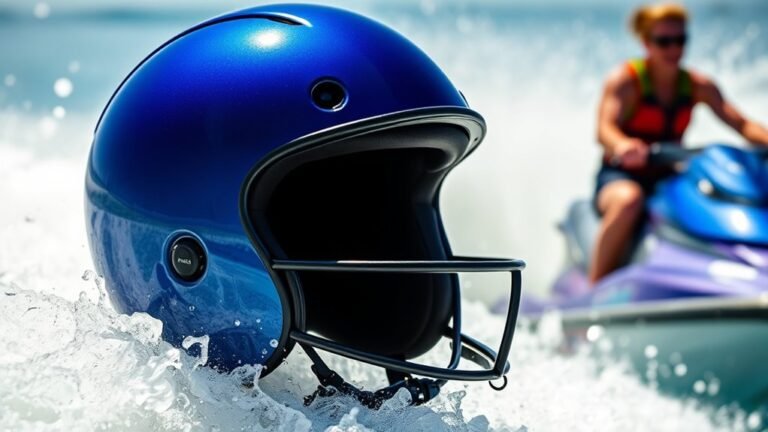The Best Helmet Materials for Saltwater Environments
For saltwater environments, your helmet needs to be made of materials that resist corrosion and offer impact protection. Polycarbonate provides durability, while fiberglass is lightweight and strong. If you seek premium safety, choose carbon fiber. Budget-friendly options like thermoplastic and versatile nylon also perform well. Consider Kevlar for enhanced safety features. Don’t overlook coatings and treatments that enhance longevity and visibility. Each material has unique advantages, and there’s more to explore about them.
Understanding the Importance of Helmet Materials
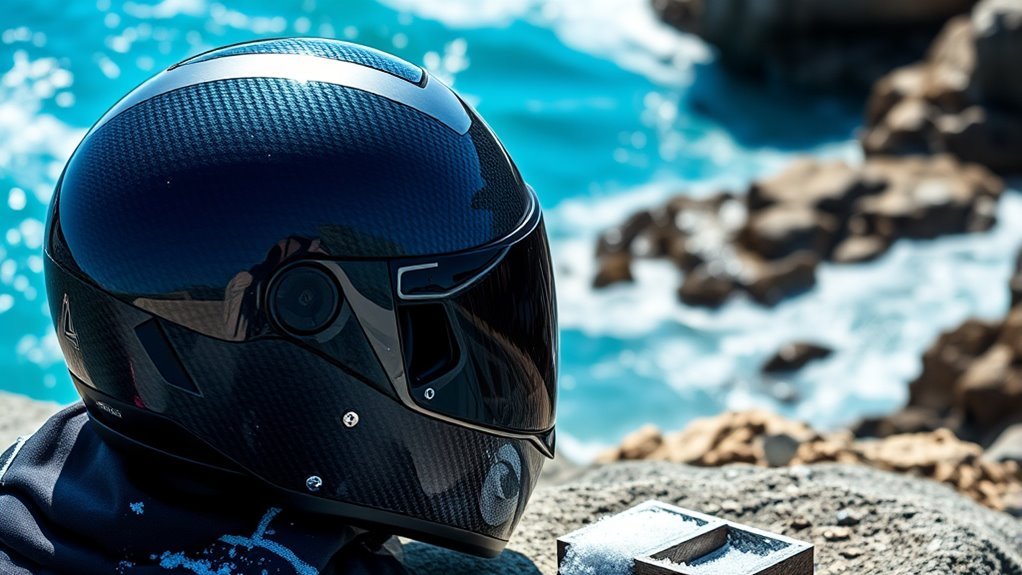
When you’re traversing saltwater environments, the materials used in your helmet can considerably impact its performance and longevity. Choosing high-quality materials is essential for maximizing your helmet lifespan, as saltwater can corrode and degrade inferior substances. Opt for helmets crafted from corrosion-resistant materials, which not only withstand harsh conditions but also guarantee peak safety. Regular maintenance is key; rinse your helmet with fresh water after each use to remove salt deposits, and inspect it periodically for signs of wear. By following these maintenance tips, you’ll help your helmet perform at its best, providing both protection and comfort. Remember, investing in the right materials and proper care will enhance your experience in the water, allowing you the freedom to explore confidently.
Polycarbonate: A Durable Choice
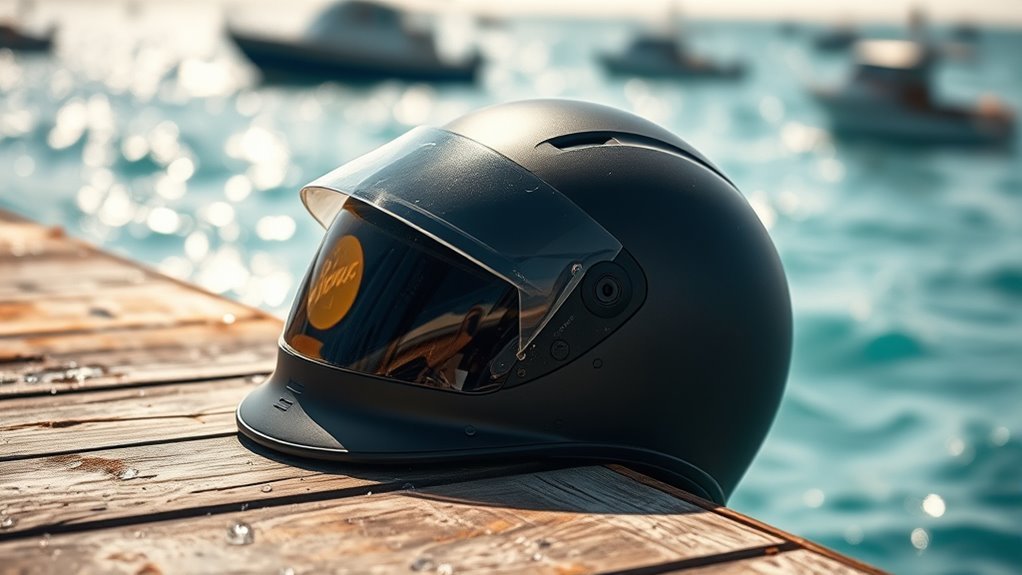
Although many materials are suitable for helmet construction, polycarbonate stands out as a particularly durable option for those traversing saltwater environments. Its inherent strength and impact resistance make it ideal for protecting your head from potential hazards. One of the key polycarbonate benefits is its resistance to saltwater corrosion, ensuring long-lasting performance even in harsh conditions. This material’s lightweight nature adds to the overall comfort, allowing you to wear it for extended periods without fatigue. Common polycarbonate applications include marine helmets and recreational water sports gear, where reliability and safety are paramount. By choosing a polycarbonate helmet, you’re investing in a product that offers both durability and protection, enabling you to focus on your adventures with confidence.
Fiberglass: Lightweight and Strong
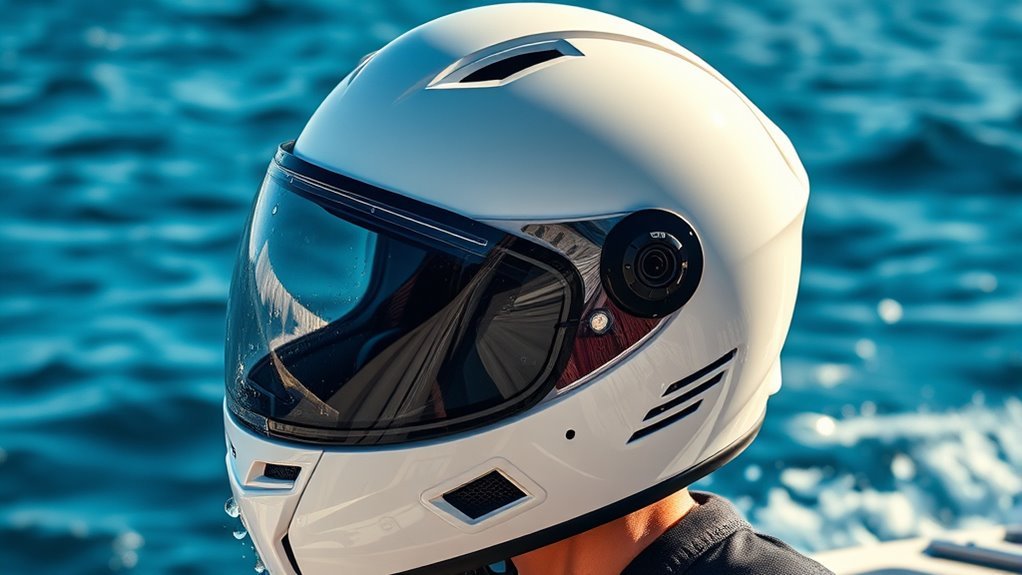
When considering helmet materials for saltwater environments, fiberglass stands out due to its excellent corrosion resistance. Not only does it provide superior impact absorption characteristics, but it also offers a significant weight advantage compared to other materials. This combination makes fiberglass an ideal choice for those seeking both protection and comfort in challenging conditions.
Corrosion Resistance Benefits
Fiberglass helmets stand out in saltwater environments due to their exceptional corrosion resistance. Unlike metal helmets, fiberglass is inherently resistant to the detrimental effects of salt and moisture, ensuring longevity even under harsh environmental factors. This material’s non-corrosive nature means you won’t have to worry about rust or degradation, allowing you to focus on enjoying your time in the water without compromising safety. Additionally, fiberglass can be easily cleaned and maintained, further enhancing its durability. When you’re maneuvering through saltwater conditions, the corrosion resistance of fiberglass helmets provides peace of mind, knowing that your gear will withstand the elements. Choosing fiberglass means choosing a reliable, low-maintenance option that supports your adventurous spirit.
Impact Absorption Characteristics
The advantages of fiberglass helmets extend beyond corrosion resistance; they also excel in impact absorption. When you’re in a saltwater environment, the ability to dissipate impact energy is essential for your safety. Fiberglass is known for its excellent material performance, effectively absorbing shocks while distributing impact forces across its surface. This minimizes the risk of injury during unexpected collisions or falls. The structural integrity of fiberglass allows it to maintain its shape and effectiveness even after repeated impacts, ensuring you stay protected over time. With its unique combination of lightweight strength and superior impact absorption, fiberglass helmets provide the freedom you desire while traversing challenging environments without compromising safety. Choose wisely; your protection relies on these key characteristics.
Weight Advantage Comparison
Choosing the right helmet material can considerably impact your comfort and performance, especially in saltwater environments. Fiberglass helmets are renowned for their excellent weight distribution and strength. With a lower material density compared to alternatives like polycarbonate or metal, fiberglass helmets provide a lightweight feel without compromising durability. This advantage means you can enjoy extended periods of wear without fatigue, allowing for greater freedom in your activities. Additionally, the strength-to-weight ratio of fiberglass enhances impact resistance, making it a prime choice for those maneuvering through challenging saltwater conditions. When you prioritize lightweight design alongside robust protection, fiberglass emerges as a compelling option, ensuring you stay agile and comfortable on the water.
Carbon Fiber: Premium Protection
While many materials offer varying degrees of protection, carbon fiber stands out as a premier choice for helmets used in saltwater environments due to its exceptional strength-to-weight ratio and corrosion resistance. The carbon fiber benefits include high impact resistance and longevity, ensuring you stay safe during your adventures. Its lightweight nature allows for extended wear without fatigue, making it ideal for those who crave freedom on the water.
| Carbon Fiber Benefits | Carbon Fiber Applications |
|---|---|
| High Strength | Marine Sports Helmets |
| Lightweight | Watercraft Racing |
| Corrosion Resistance | Diving Helmets |
| Impact Absorption | Offshore Work Gear |
Using carbon fiber, you’re investing in premium protection that enhances your experience in saltwater environments.
Thermoplastic: Budget-Friendly Option
When it comes to cost-effective helmet options for saltwater environments, thermoplastic materials offer a practical solution without compromising essential safety features. In an affordability comparison, thermoplastic helmets often come at a lower price point than other materials while providing decent impact resistance and durability. The thermoplastic advantages include lightweight construction, which enhances comfort during extended use, and resistance to corrosion from saltwater exposure. These helmets are also easier to manufacture, leading to lower costs without sacrificing performance. If you’re looking for a reliable and budget-friendly option, thermoplastic helmets can be a smart choice, allowing you to enjoy your time on the water while ensuring your safety. Embracing thermoplastic means balancing protection and financial freedom.
Nylon: Versatile and Resilient
Nylon helmets stand out in saltwater environments due to their exceptional versatility and resilience. One of the key nylon benefits is its remarkable resistance to corrosion and UV degradation, making it ideal for marine applications. These helmets can withstand harsh conditions while maintaining structural integrity, allowing you to focus on your adventures without worry.
Nylon’s lightweight nature guarantees comfort during prolonged use, while its flexibility provides a snug fit, enhancing safety. Whether you’re sailing, kayaking, or engaging in other water sports, nylon helmets offer the protection you need. Additionally, their ability to be molded into various designs means you can find a style that suits your freedom-loving spirit. Investing in nylon helmets assures that you’re well-equipped for any saltwater challenge.
Kevlar: Enhanced Safety Features
If you’re seeking helmets that prioritize safety in saltwater environments, Kevlar is an excellent choice. Known for its remarkable strength-to-weight ratio, Kevlar offers several advantages, including high impact resistance and durability against harsh elements. In applications ranging from marine sports to commercial fishing, its lightweight nature guarantees comfort without compromising protection. Furthermore, Kevlar’s resistance to corrosion makes it particularly suitable for saltwater exposure, minimizing degradation over time. This means you can enjoy your activities with the confidence that your helmet provides ideal safety. By choosing helmets constructed with Kevlar, you’re investing in a product designed to withstand the rigors of demanding environments while keeping you safe and free to explore the waters.
Coatings and Treatments for Added Protection
While Kevlar helmets provide excellent durability and protection, adding specialized coatings and treatments can further enhance their performance in saltwater environments. You should consider several coating types, such as polyurethane or epoxy, which offer superior resistance to corrosion and UV damage. These coatings create a barrier that prevents saltwater from penetrating the helmet material, extending its lifespan. Treatment methods like electroplating can also provide a robust defense against rust and wear. Additionally, applying anti-fog and anti-scratch treatments can improve visibility and usability in diverse conditions. By selecting the right combination of coatings and treatments, you guarantee your helmet remains reliable, allowing you to enjoy your aquatic adventures with confidence and peace of mind.
Frequently Asked Questions
How Often Should I Replace My Saltwater Helmet?
You should replace your saltwater helmet every three to five years, depending on usage and exposure to harsh conditions. Regular maintenance tips include rinsing it with fresh water after each use and inspecting for cracks or degradation. If you’re noticing wear or if it’s been involved in an impact, it’s time for a replacement. Staying proactive about replacement frequency guarantees your safety and freedom while enjoying saltwater activities.
Can I Use a Freshwater Helmet in Saltwater?
You can’t use a freshwater helmet in saltwater. Freshwater helmet durability isn’t designed to withstand the corrosive effects of saltwater, which can lead to rapid deterioration. Saltwater helmet compatibility is essential for maintaining safety and performance. Using a helmet meant for freshwater in a saltwater environment may compromise its structural integrity and protective features. For your safety, always opt for a helmet specifically designed for saltwater conditions.
What Is the Best Way to Clean a Saltwater Helmet?
To clean a saltwater helmet, start by rinsing it thoroughly with fresh water to remove salt deposits. Use gentle cleaning techniques, like a soft brush or cloth, to avoid scratching. For stubborn stains, a mild soap solution can help. After cleaning, make sure it’s completely dry before storage to prevent mold. Regular maintenance tips include checking for signs of wear and tear, and storing it in a cool, dry place to prolong its lifespan.
Are There Specific Brands Recommended for Saltwater Helmets?
For saltwater helmets, you should consider brands like Bell, Shoei, and HJC. These companies are known for their durability and effective saltwater protection. They’ve designed their helmets to withstand harsh marine conditions while maintaining comfort and safety. When choosing, look for features like corrosion-resistant materials and proper ventilation. Investing in a reputable brand guarantees you’re getting a helmet that’ll last, giving you the freedom to enjoy your time on the water worry-free.
How Do I Determine My Helmet Size for Saltwater Use?
To determine your helmet size for saltwater use, start by measuring your head circumference with a flexible tape measure. Once you have that measurement, consult the size chart provided by the helmet manufacturer. Guarantee a snug fit; it shouldn’t be too tight or too loose. Adjust any internal padding if necessary. A properly fitted helmet enhances safety and comfort, allowing you to enjoy your time in the water with confidence.
